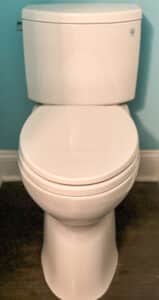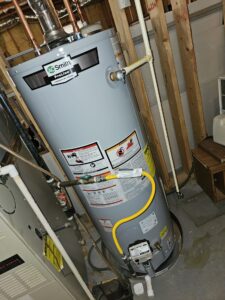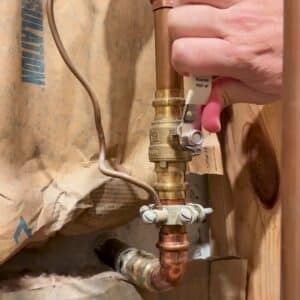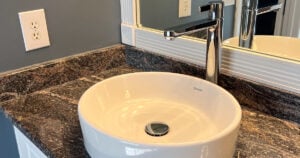Is Your Toilet Leaking? Here’s What To Do
If you find a toilet leaking in your home, you may be able to find the source of the problem yourself. A toilet can leak in different ways, and depending on where the water is coming from, the repair process may be simple or complicated. Some leaks can be handled with basic tools and a bit of know-how, while others may require the help of a professional plumber.

This blog post walks you through the most common causes of a toilet leaking, explaining how to find where the water is coming from, and what you may be able to do to fix your leaking toilet.
We’ll focus specifically on the most common calls we get about a toilet leaking: toilet leaking at base and toilet leaking from tank.
Note: This is general information about what to do if your toilet is leaking. We always recommend calling a professional to avoid home damage.
Why Is My Toilet Leaking?
Toilets are simple in design but they rely on watertight seals to work properly. Over time, those seals can wear down, bolts can loosen, and connections can weaken. That’s when leaks start to appear. In some cases, what a homeowner calls a toilet leaking may actually be a running toilet—a separate issue where water continually flows inside the bowl. While that is still a plumbing problem, it’s different from water leaking outside of the toilet onto your floor. (We cover running toilets in more detail in our blog post about how to fix a running toilet.)
The first step in solving the problem is figuring out whether you have a toilet leaking from tank, a toilet leaking at base, or another issue entirely.
Toilet Leaking From Tank
If you notice water around the back of the toilet or dripping onto the floor when you flush, there’s a good chance you have a toilet leaking from tank. The tank is attached to the bowl with bolts, and between them sits a gasket that forms a watertight seal. When those bolts loosen or the gasket starts to fail, water can escape.
How to Stop a Leak From the Tank
The very first thing you should do is turn off the water to the toilet. Look for the shut-off valve near the base of the toilet, usually on the wall or floor. Turn it clockwise until the water supply is completely closed. Once the water is off, flush the toilet to drain the water from the tank. Any remaining water should be removed with a wet/dry vacuum to keep things clean and avoid spills.
Tightening Tank Bolts
With the tank drained, check the bolts that hold the tank to the bowl. These bolts can sometimes loosen over time. Carefully tighten them, but be cautious: over tightening can crack the porcelain or actually create a worse leak. Tighten them evenly and only enough to reestablish a snug fit.
Replacing the Tank-to-Bowl Gasket
If tightening doesn’t stop the toilet leaking from tank, the gasket that sits between the tank and the bowl may need to be replaced. Replacing this gasket involves disconnecting the water supply, draining the tank, and lifting the tank off the bowl to install a new gasket. This repair can be challenging for a homeowner who doesn’t already have plumbing experience, as it requires the right size and style of gasket, which plumbers typically keep stocked. For many people, this is the point where calling a plumber is the best choice.
Different Toilet Designs and Tank Leaks
It’s worth noting that not all toilets have this type of tank-to-bowl connection. Two-piece toilets, where the tank and bowl are separate, are the ones that develop a toilet leaking from tank problem. One-piece toilets, on the other hand, are molded as a single unit, so there’s no gasket or bolt connection between the tank and bowl. While that means they don’t suffer from tank-to-bowl leaks, one-piece toilets do come with their own unique challenges when repairs are needed. You can read more about those in our guide to different types of toilets.
Toilet Leaking At Base
A toilet leaking at base is another very common problem, and one that can cause major damage if not handled quickly. The leak often shows up as water pooling around the floor at the bottom of the toilet. Sometimes, you may only notice the leak when you sit on the toilet, because the weight causes the toilet to shift slightly and forces water past the seal.
Why Toilets Leak at the Base
Most base leaks happen because the wax ring seal under the toilet has failed. The wax ring is a simple but critical part of the installation. It creates a watertight connection between the toilet and the drainpipe. Over time, the wax can degrade, compress, or shift, which allows water to escape.
How to Replace a Wax Ring
Fixing a toilet leaking at base typically requires removing the toilet, replacing the wax ring, and resetting the toilet back in place. Here are the main steps:
- Turn off the water to the toilet. In fact, turn off the water to your whole home. This step cannot be skipped. If you break or disconnect the supply line without shutting off the water first, you can flood your bathroom in seconds.
- Drain the toilet completely by flushing after turning off the supply. Use a vaccuum to remove residual water.
- Disconnect the supply line.
- Unbolt the toilet from the floor and carefully lift it straight up. Keep in mind that toilets are heavy, and this step can be much harder than it looks. To reduce the weight you’re lifting, you may want to separate the tank from the bowl and remove the toilet in pieces.
- Scrape off the old wax ring and replace it with a new one. Wax rings come in different sizes (large and small), so it’s important to have the correct size before starting.
- Reset the toilet in place, making sure it’s aligned properly before bolting it back down.
Because of the weight of the toilet and the risk of damaging flooring or plumbing connections, many homeowners prefer to have a plumber handle this repair. It looks simple in theory but can quickly become a bigger mess if not done carefully.
Consider Not Putting the Old Toilet Back
If you’re already going through the work of removing a toilet to fix a leak, it’s worth considering whether the toilet itself is nearing the end of its life. Older toilets often use more water with every flush and may lack the efficiency and cleanliness features that come standard in modern designs. Today’s toilets, from reputable brands like Toto and American Standard not only save water but also feature advanced glazes that help the bowl stay cleaner longer. Since removing and reseating a toilet requires time, tools, and careful handling, many homeowners see this as the perfect opportunity to upgrade rather than reinstall an aging fixture. Whether you’re hiring a professional or tackling the project yourself, replacing the old toilet while it’s already out can be a smart move that adds convenience, efficiency, and long-term value to your home.
Is It Really a Leak?
Sometimes homeowners call about a toilet leaking when what they really mean is that the toilet is running. A running toilet is when water continues to flow into the bowl even when it hasn’t been flushed. This can often be fixed by adjusting or replacing parts inside the tank, such as the flapper or fill valve. While it doesn’t cause water on the floor, it can waste hundreds of gallons of water a day, which makes it a serious problem for your water bill.
When to Call a Plumber
While some toilet leaks can be repaired with basic tools, others require more expertise. Here are some signs it’s time to call for professional help:
- The toilet leaking from tank continues even after tightening bolts.
- The base leak persists after replacing the wax ring.
- You’re unsure of the toilet type and which repair applies.
- You don’t have the tools or experience to safely lift and reset a toilet.
- The leak has already caused water damage to your flooring or subfloor.
A licensed plumber has the parts on hand, the tools for the job, and the experience to make sure the repair is done right the first time.
Preventing Toilet Leaks
Regular maintenance can reduce the chances of your toilet leaking in the future. Here are some tips:
- Check the supply line and shut-off valve for signs of wear or corrosion.
- Test the stability of the toilet by gently shifting it; movement can indicate a failing wax ring.
- Look inside the tank occasionally to check the condition of bolts and gaskets.
- Call for inspection if you notice moisture on the floor near the toilet, even if it’s just a small amount.
Final Thoughts
A toilet leaking is more than just an inconvenience—it can lead to significant water damage and higher utility bills if ignored. Whether it’s a toilet leaking from tank or a toilet leaking at base, identifying the source of the problem is the first step toward fixing it. While some repairs are manageable for handy homeowners, others are best left to professional plumbers who have the tools, parts, and experience to handle them quickly and correctly.
At Aaron Services: Plumbing, Heating, Cooling, we’ve been helping families solve toilet problems since 1978. With same-day service, flat rates, and no extra costs, you can count on us for reliable repairs whenever you need them.






